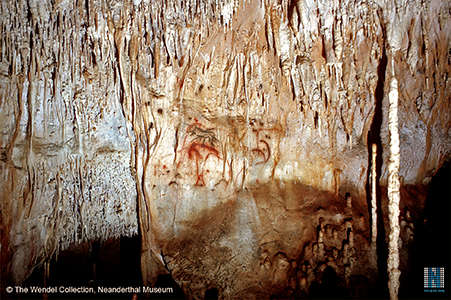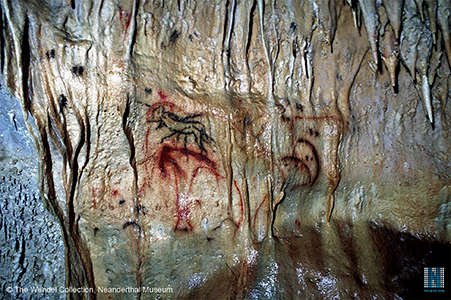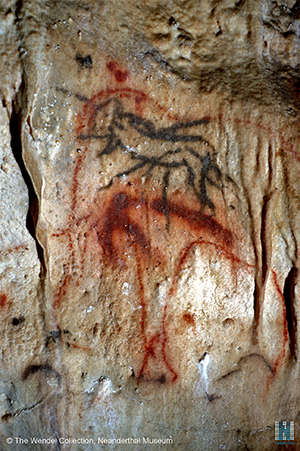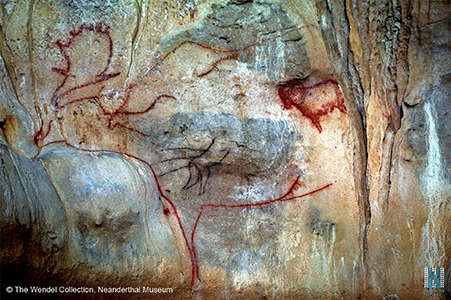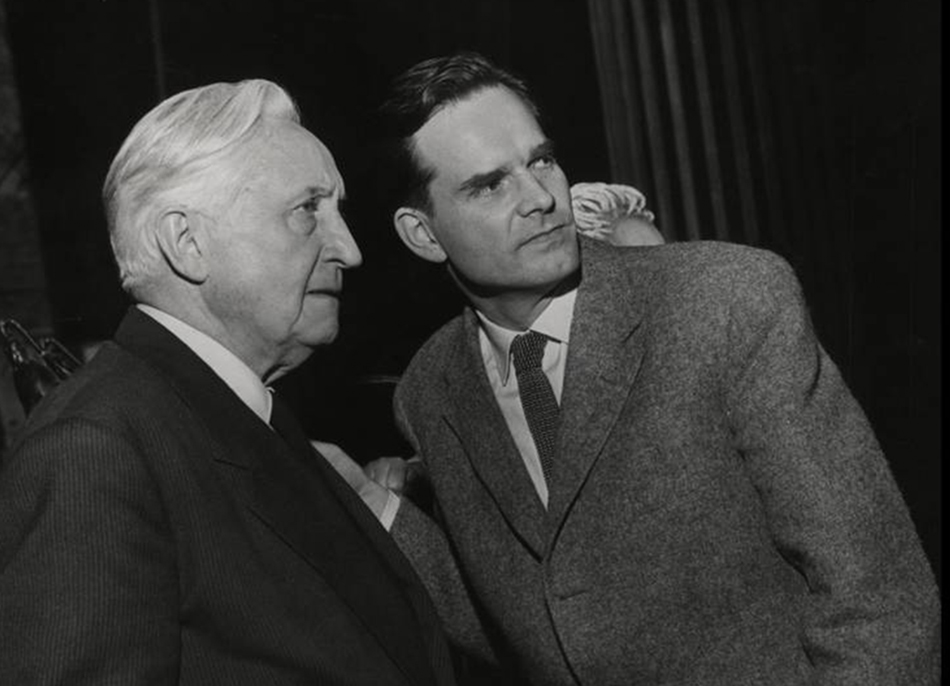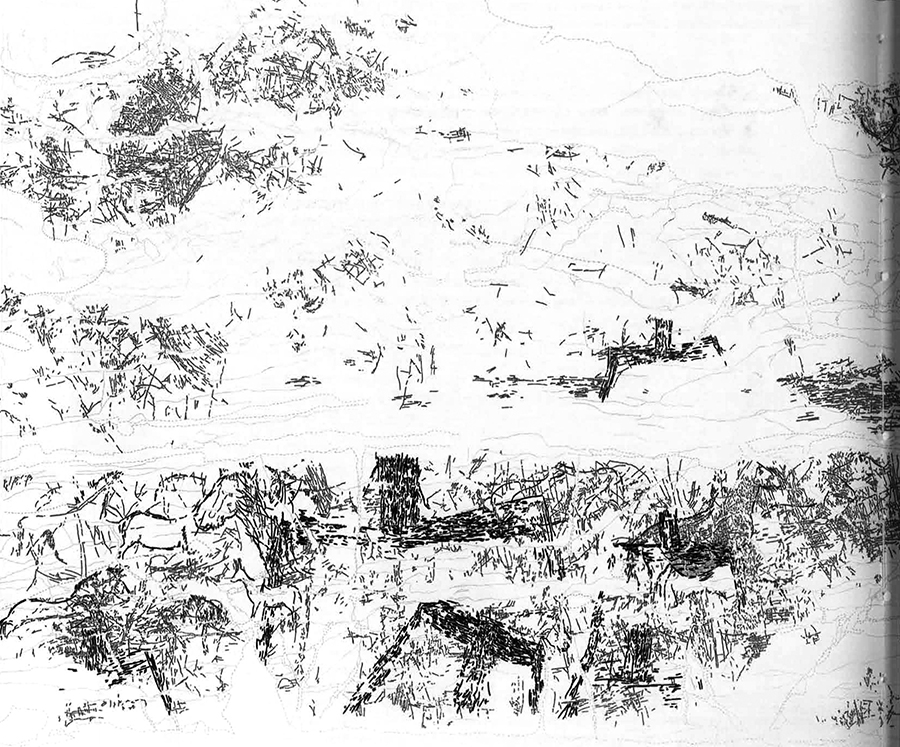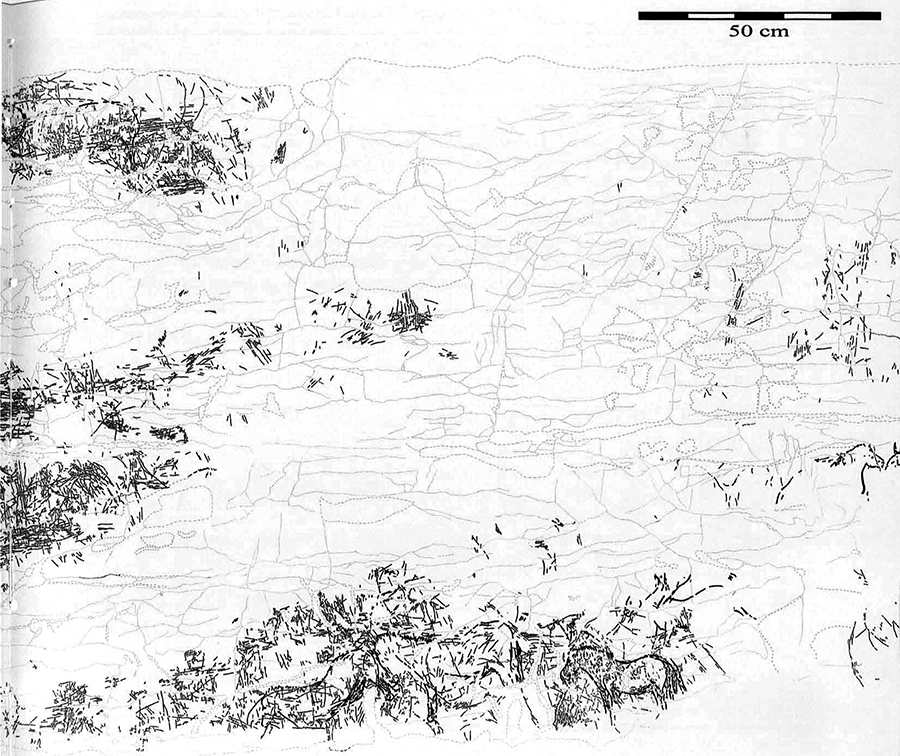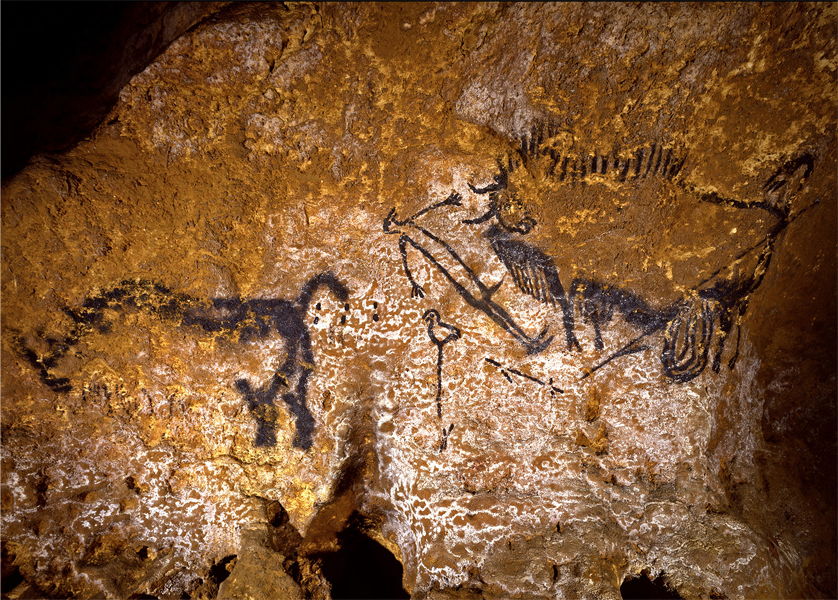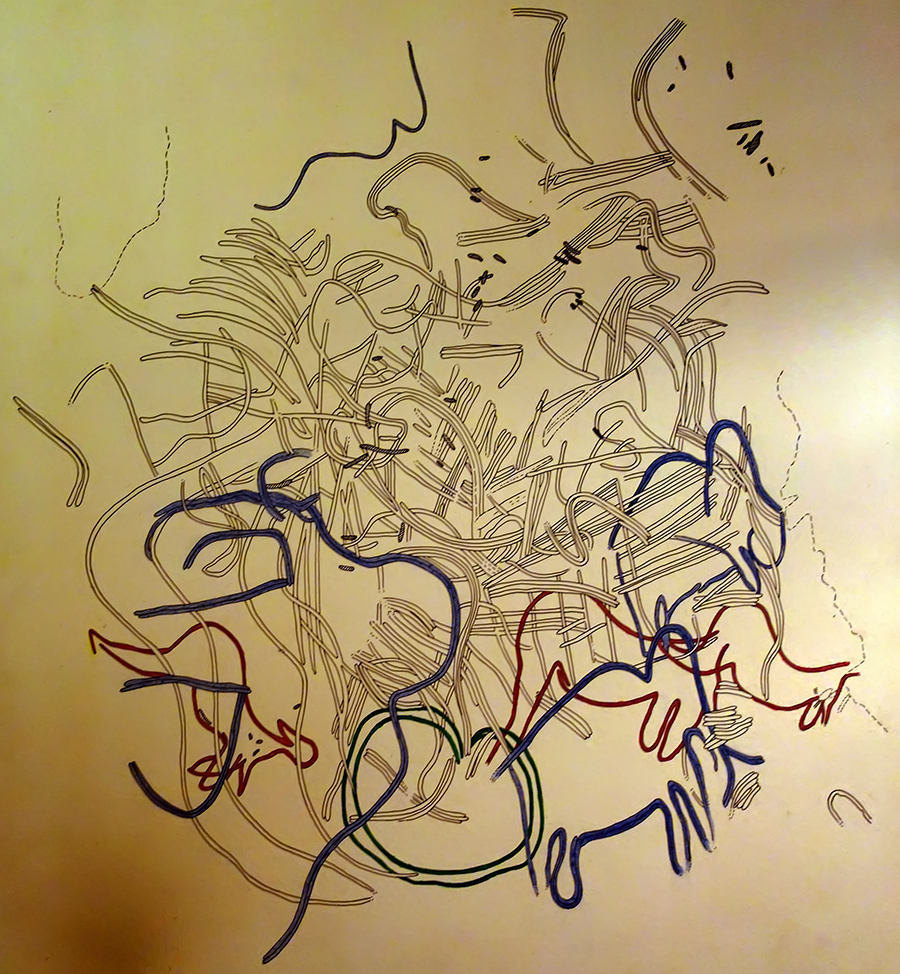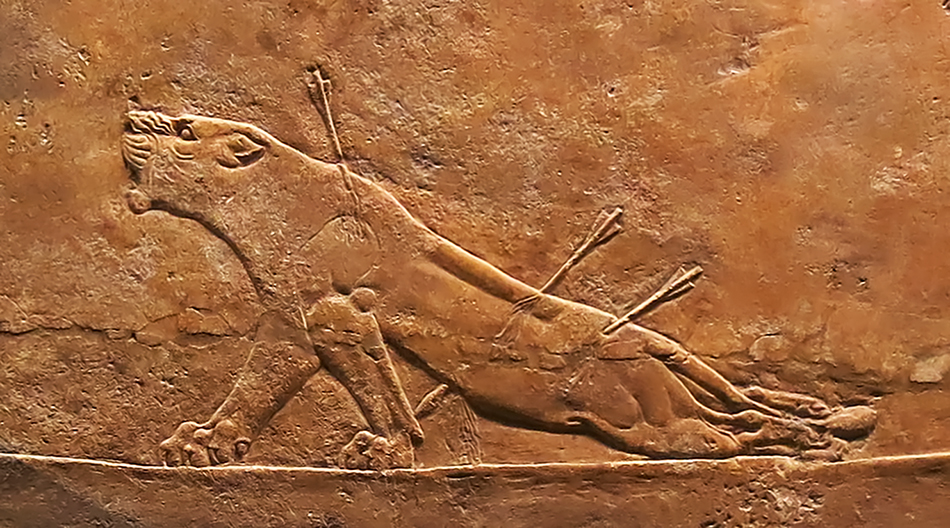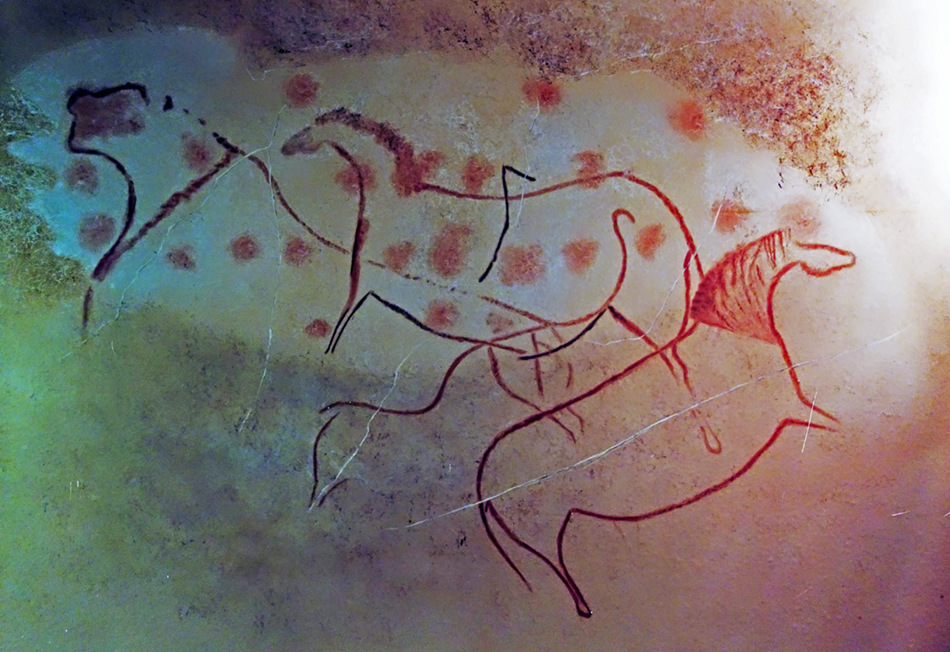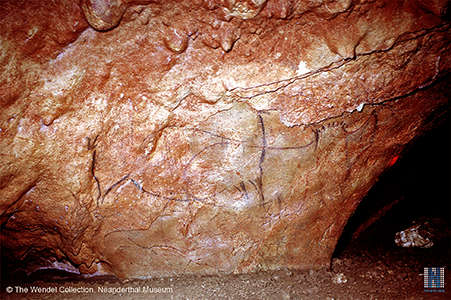Back to Don's Maps
Heinrich Wendel
From 1964 until his death in 1980, the collector Heinrich Wendel (1915 - 1980) was head of set design at the Deutsche Oper am Rhein in Düsseldorf and one of Germany's most renowned stage designers. The design of spaces through light and projection art was a central part of his artistic work. With this in mind, he made several trips to the Franco-Cantabrian region between 1964 and 1970 with the aim of finding inspiration for his work in prehistoric cave art.
In doing so, he proceeded highly professionally and with scientific meticulousness according to a uniform concept. He also took photographs in the non-public areas of the caves. In the course of time, an extensive photo archive of about 3 000 pictures was created. This photo archive not only documents the state of conservation of cave art from around 50 caves, but it also reveals the perspective of the stage designer: cave art as a means of transforming a given natural space into architecture, into a stage.
The Wendel Collection comprises some 3 000 images of Ice Age cave art from around 50 caves in France and Spain.
Text above: © neanderthal.de/en/our-museum/research
The following is, sadly, the only paper he is known to have written.

He needed assistants to help with carrying bulky photographic gear and aid with positioning and aiming lighting for his photographs.
Photo: Galerie des Modelages, Grotte de Bedeilhac, Heinrich Wendel (© The Wendel Collection, Neanderthal Museum)
Heinrich Wendel on ice age religion
Heinrich Wendel, Düsseldorf, on ice age and ancient Egyptian sanctuaries, seen as places of a religious rebirth
Source: Wendel (1975)
Translation by Ralph Frenken and Don Hitchcock
Ice Age and Ancient Egyptian sanctuaries, seen as places of a religious rebirth
Author: Heinrich Wendel
Every year since 1961, I have travelled through the caves with traces of Ice Age culture in southern France and northern Spain with helpers, special permits and photographic resources. Similarly equipped, I have been travelling through Egypt since 1963, after noticing a connection between the innermost sanctuaries of the two cultures.In the Ice Age caves, which are decorated with paintings, engravings and signs, small sanctuaries stand out. Only a single person can lie stretched out or bent over in them. The space of these sanctuaries in the rock of the caves was neither created by Ice Age man nor prepared by him with hammer and chisel for his purposes. He took them as nature offered them to him and at most chiselled away a few stalactites. But he decorated them with images and signs that today indicate the significance that these 'chambers' may have had for the ritual use of Ice Age man.
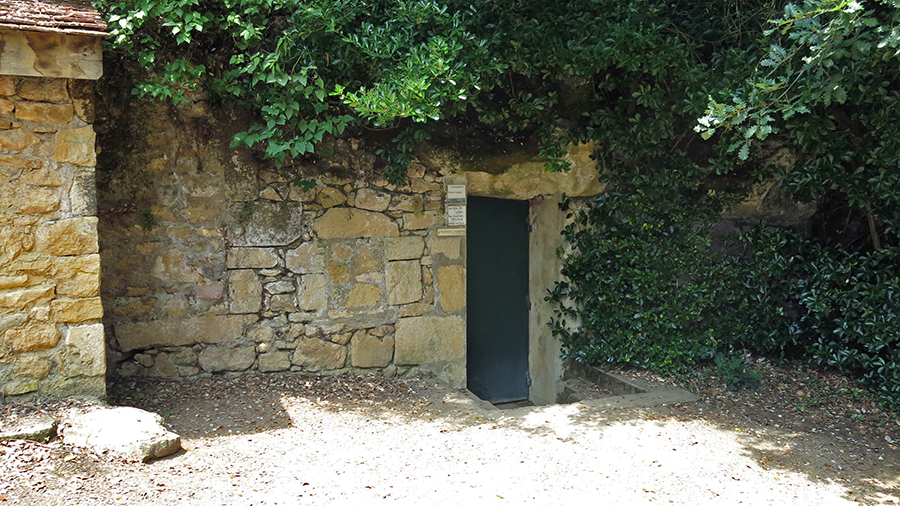
Main exterior entry to the decorated Grotte de Cougnac
Photo: Don Hitchcock 2014
The Cougnac caves near Gourdan, les Grottes de Cougnac, contain a small sanctuary, called the 'sack', in which a person can lie stretched out. The fact that this room, which is level with the cave floor, was important to Ice Age man is confirmed by a number of dots and signs that he painted on the walls inside. On the right above the dugout is a large painting that appears to be the end of a cycle of paintings covering the walls from the left. It depicts a mammoth composition: Exactly parallel to a purely natural formation in the wall, in which a mammoth can be seen - which Ice Age Man has confirmed with a few supporting lines (teeth) - a smaller mammoth inside has been painted completely inside in red colour.
In the overlapping heads of these mammoth images, a human is depicted in black. His head, exactly in the centre of the mammoth heads, wears a bird-like animal mask. His body is covered with spears. To his right, a second, barely recognisable human figure in light brown paint is only noticed later. It is painted as if falling out of the mammoth's head. It too has spears and perhaps a mask.
In this image we can see the outline of a red ochre mammoth completed in a thick red line, with a 'wounded man with many spears' in black, with many spears stuck in his naked body overlapping it, two large black horns of an ibex, a diagram of a mammoth with straight back, his head and trunk, then the black outline of the skull and the beginning of the back of a mammoth, and frequent pairs of fingerprints in black and red.
These paintings have been drawn on a thick coating of calcite on the walls, some of which were covered subsequently with a thin veil of calcite. Depending on the humidity of the underground environment and the water status of the walls, the legibility of the paintings varies. In the autumn in general painted strokes are very visible; by contrast in winter (the period in which this photograph was taken), the features become less distinct. The attenuation of the colours is probably due to a temporary clouding of the veil of concretion deposited on the paintings. The phenomenon has a periodic nature, and closely follows climate fluctuations.
Photo: Heinrich Wendel (© The Wendel Collection, Neanderthal Museum)
Text: adapted and translated from: www.culture.gouv.fr/culture/conservation/fr/grottes/Pageshtm/3191.htm
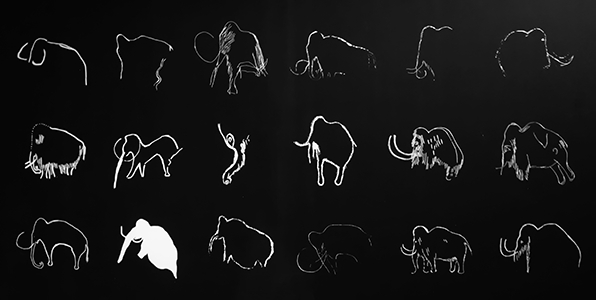
This shows the broad range from a large number of caves of the outlines of mammoths, often a preferred method of representation of this animal.
Photo: Ralph Frenken 2019
Source: Display, Le Parc de la Préhistoire de Tarascon-sur-Ariège
Closeup of the 'wounded man with many spears'.
Photo: Heinrich Wendel (© The Wendel Collection, Neanderthal Museum)

This is a good view of the right hand part of the main panel, with an Ibex and a mammoth and the wounded man with many spears visible.
Photo: Heinrich Wendel (© The Wendel Collection, Neanderthal Museum)
In the 'preceding' pictures, a few metres to the left, another human figure can be seen. It stands out clearly, in a black colour, from the chest of a red-painted animal image that resembles an elk with large antlers. The figure is also marked with spears. But it is missing its head.
On this red Megaloceros is outlined the 'wounded man' with three spears in his back, a deer on the neck of the Megaloceros, and a well proportioned and painted Ibex.
Photo: Heinrich Wendel (© The Wendel Collection, Neanderthal Museum)

The 'wounded man' has two spears in his back, and one in his upper thigh or buttock. No blood has been indicated, it is a simple outline in black.
Photo: Heinrich Wendel (© The Wendel Collection, Neanderthal Museum)
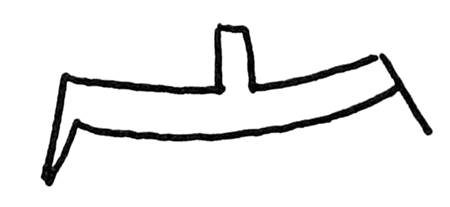
At the beginning of the 'picture cycle', two smaller niches show several variations of a sign that recurs in the Pech Merle cave (left) in an even closer connection with the 'spear man'.
( Note that these aviform signs are now generally known as 'Placard Signs' because of the number of them depicted on the walls of Grotte Placard. A dozen aviform signs identical to those discovered in the caves of Pech Merle and Cougnac were unearthed in 1990 on the walls buried in the Solutrean layer of La Grotte du Placard, which suggests a cultural grouping or even a common ancestor who visited these caves which are separated by more than 150 km. Similar signs were found in the Cosquer Cave near Marseille, 500 km away. The figures date back about 20 000 years to the Solutrean. - Don )
After many comparisons of Ice Age signs with regard to their gender reference, I would like to categorise this sign as 'double-gendered'. In both images, the multiple and different emphasis on the head region, which was probably also decisive for the experience of consciousness in Ice Age man, and the intensification of the images up to the one-man reclining space are striking. The frequently recurring image of the 'Spear Man' can hardly be regarded as a depiction of execution.

Plafond des Hiéroglyphes
The photographer, Heinrich Wendel.
No one charged with recording any of the caves of Europe has done as well as this man, a volunteer, has done. His photographs are the largest single resource for the painted caves of Europe. He or his heirs donated his beautifully made images to the Neanderthal Museum, who generously made them available to all.
Photo: Heinrich Wendel (© The Wendel Collection, Neanderthal Museum)
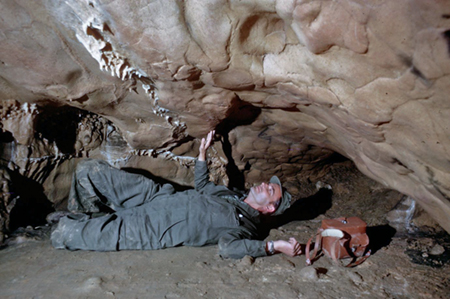
Heinrich Wendel in the 1970s at Le Portel, Galerie Breuil.
Photo: Heinrich Wendel (© The Wendel Collection, Neanderthal Museum)
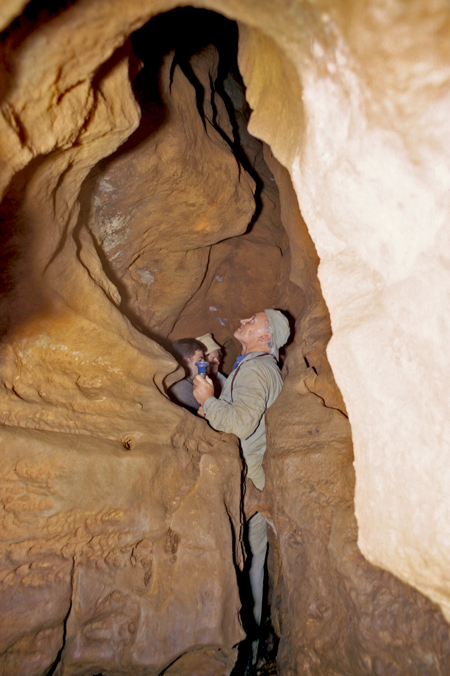
Heinrich Wendel at Grotte de Bernifal.
Photo: Heinrich Wendel (© The Wendel Collection, Neanderthal Museum)
Artistic director Carl Ebert (Deutsche Oper) in conversation with Heinrich Wendel. Wendel became head of set design at the Deutsche Oper am Rhein in Düsseldorf in 1964 and worked as one of Germany's most renowned stage designers until 1980.
Photo: Harry Croner
Source and text: © sammlung-online.stadtmuseum.de/Details/Index/469151
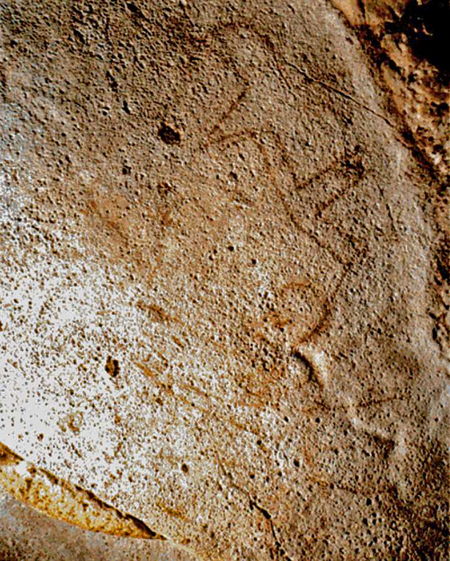
The aviform 'Placard Sign' and speared man in the cave of Pech Merle.
Photo: Bahn and Vertut (1997)
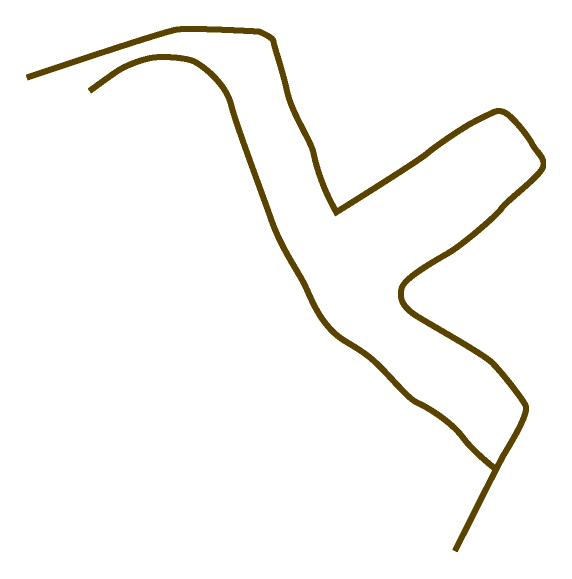
Placard Sign from Pech Merle redrawn. Note the bird like shape of this sign. These signs occur in eleven painted forms at Cougnac, three times at Pech Merle, and as seven engraved forms at Grotte du Placard. They are possibly Solutrean - Bahn and Vertut (1997)
Photo: Redrawn by Don Hitchcock after Bahn and Vertut (1997)

Type Placard sign and a man wounded by several spears, in red ochre. Height 75 cm, from Grotte du Pech-Merle, Lot. Probably from the Solutrean.
Photo: Michel Lorblanchet, via http://ma.prehistoire.free.fr/signe_au_pm.htm
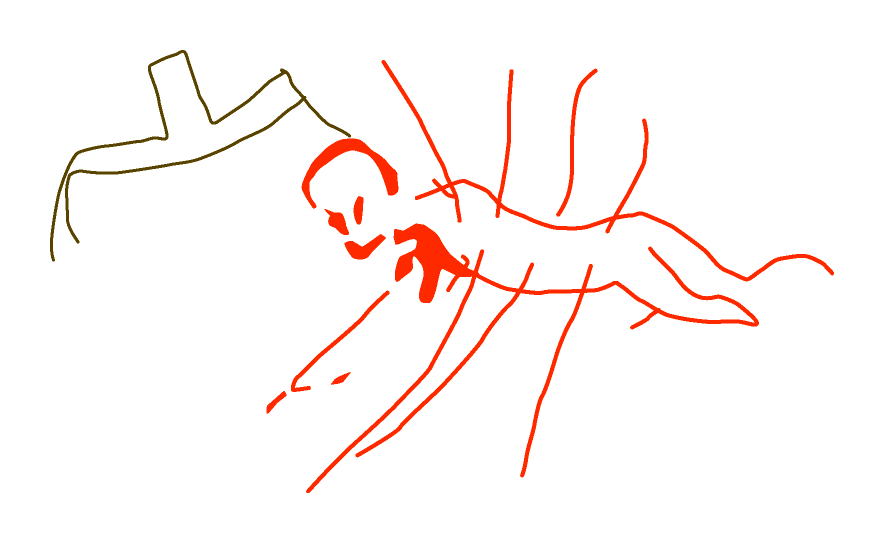
Type Placard sign and a man wounded by several spears, in red ochre. Height 75 cm, from Grotte du Pech-Merle, Lot. Probably from the Solutrean, showing the outline of the "le Placard" sign and the man wounded with spears.
Photo: Redrawn by Don Hitchcock after Michel Lorblanchet, via http://ma.prehistoire.free.fr/signe_au_pm.htm
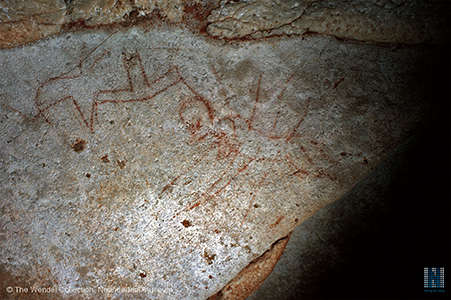
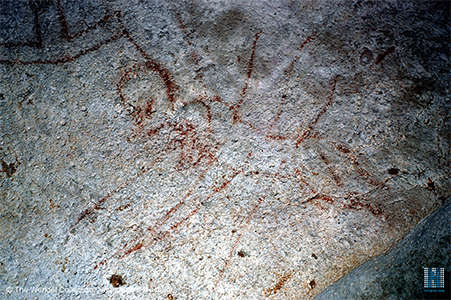
The Wounded Man figure from Grotte du Pech-Merle, Lot has been pierced by a number of spears. It is not certain what this is meant to represent - the result of a fight between neighbouring tribes, the ritual killing of a wrong doer from the tribe? No one knows.
To the left of this image is another enigmatic figure, variously called a bird figure, an Aviform, or a Placard figure, after the Placard Cave where this symbol also occurs.
Photo: Heinrich Wendel (© The Wendel Collection, Neanderthal Museum)

There appears to be another aviform or Placard figure to the left of the one beside the Wounded Man, different in form and more bird-like, but of the same general type.
Photo: Grotte du Pech-Merle, Lot, Heinrich Wendel (© The Wendel Collection, Neanderthal Museum)
Reproduction of the engravings of the principal decorated panel at Placard, the photo montage below providing a more detailed view.
The engravings are of two categories: figurative (representations of animals) and abstract (signs).
They are the result of the campaigns of excavations directed by Jean Clottes with the collaboration of Louis Duport and Valérue Feruglio, from 1990 to 1993 and in 1995.
Drawing: V. Feruglio.
Source: Clottes et al. (2010)
Grotte du Placard engravings as physical objects
These objects would appear to have been created by scanning the very small engravings, then enlarging and printing them out on a digital 3D printer. This technique is set to revolutionise the display of the world's archaeological treasures by making high quality reproductions available to all at a modest cost, with the file sent to the recipient, who then uses their own 3D printer to print them out. However the result is still the colour of the plastic used, often white or clear, so the resulting model still has to be realistically coloured by hand.

Engraving showing a horse and what may be an antler.
Photo: Don Hitchcock 2104
Source: Display, Grotte du Placard

Engraving showing a horse and a placard sign. The technique involves multiple strokes to build up the image.
Photo: Don Hitchcock 2104
Source: Display, Grotte du Placard


Placard sign
Photo: Don Hitchcock 2104
Source: Display, Grotte du Placard
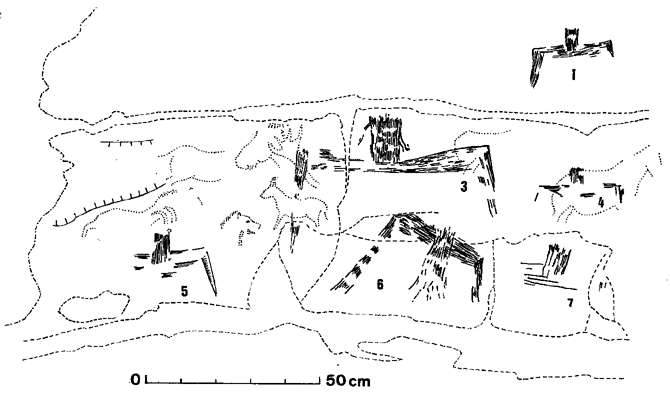
Grotte du Placard, 'signes de type Placard' (d’après relevé V. Feruglio).
Photo: Petrognani et Robert (2009)
Aviform signs
So designated because of their shape evoking that of a bird, at least as we usually depict them schematically, they are also called "Signs of the Placard type".
It is in the grotte du Placard in Charente where we find the largest number (eleven, all engraved), and it is in this site that an indirect relative dating was possible. Indeed, the wall where the signs are has been partially covered by the Solutrean levels.
This was confirmed in absolute terms by radiocarbon dating of a bone stuck in the rock above the engravings, which provided a date of 19 970 BP (Clottes et al. 1990).
This date is the youngest the engravings could be, but they may belong to an even earlier phase.
The signs are mostly made up of four elements, whose order of plotting is as follows: the vertical rectangle, the horizontal band and the 2 underlying appendages.(Clottes et al. 1990)
The model construction is found in identical form in the caves of Pech Merle, Quercy (three signs), and especially at Cougnac, with eight examples, of which only one is engraved, the latter however without reproducing the entire pattern, since only the rectangular vertical protrusion and one side of the horizontal band are represented.
If we can not precisely date any signs from Cougnac and Pech Merle, the elements of chronology at our disposal in these two caves (radiocarbon dates for the Gravettian to the Magdalenian at Cougnac, equivalent to the historical allocations at Pech Merle) this does not contradict the data of Placard, and allow us to consider a time allocation of around the Solutrean, or an earlier period. We can consider that we are facing one of the oldest examples of the dissemination of abstract symbolism in a regional area.
Text: Translated by Don Hitchock from Petrognani et Robert (2009)
Caves and abris that contain aviform signs include:
Chauvet Cave, Ardèche
Cosquer Cave, Marseille
Cougnac Cave, Lot
La Combe d'Oulen Cave, Ardèche
Le Cuzoul-des-Brasconies, Lot
Les Faux-Monnayeurs, Jura
Labastide Cave, Hautes-Pyrénées
Lascaux Cave, Dordogne
Pech Merle, Cabrerets, Lot
Le Placard, Charente
Le Portel, Ariège
Trois Frères, Ariège
The sanctuary in the Lascaux cave, known as the 'crypt', depicts a man with a bird mask, his limbs frozen and his phallus erect. The room, which is located deep below the level of the cave as a whole, makes it unnecessary to lie down in it. It is high, narrow and elongated. The reference to 'reclining' is given by the painting itself, which is the only one to dominate this place. The bird-headed man is not speared. Instead, a bison stands next to him, its entire body pierced diagonally by a lance, its belly ripped open and spilling its intestines. The bison's head turns in the direction of the spear. The bird mask and the erect phallus of the reclining man rule out the possibility that he belongs to a hunting scene as the victim of a ferocious bison. A few lines - perhaps broken lance parts - and a bird sitting on the upper end of a pole complete the right part of the picture. The left-hand section is occupied by a rhinoceros rushing away, painted in a strikingly later style, and two groups of dots.
This 'scene from Lascaux' has been interpreted as a quasi-shamanic process. This need not even be so far-fetched, especially if one judges the scene on the basis of a few details. The bird mask, the perching bird and the reclining, frozen posture of the man with an erect phallus may indicate a change of consciousness. Similarly, the bison struck so cruelly may be related to the lack of spears in the body of the reclining man.
In marked contrast to previous chambers - the Apse, the Passage or the Hall of the Bulls - the Shaft includes only a limited number of figures, eight in total. Four are animals (horse, bison, rhino and bird), while three are geometric signs.
In the centre of this composition, a human figure attracts all the attention, although only in its relation to the animals around it. This is one of the few scenes which invites the spectator to construct a story to explain what the artist has depicted.
Photo: http://www.lascaux.culture.fr/
Text: Translated and adapted from http://www.lascaux.culture.fr/
I discovered another 'spear man' in connection with a resting place on the right near the end of the 'diverticulum' in the rear part of the Altamira cave. With a little imagination, a natural formation on the low wall of the place, which can only be reached by crawling, can be seen as a plastic negative of an approximately 30 cm high human figure. This is how the Ice Age man looked at it, as he added black painted spears to its right side.
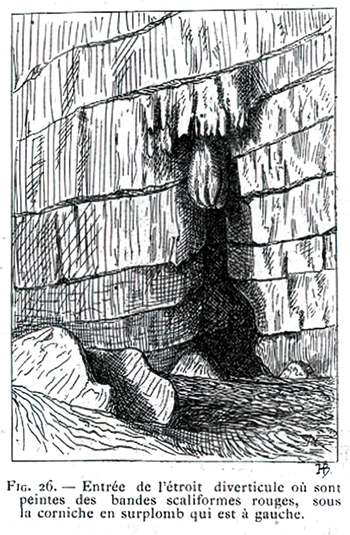
Figure 26
Entrance to the narrow diverticulum where red scaliform ( ladder shaped - Don ) bands are painted, under the overhanging cornice on the left.
Photo and text: Cartailhac et Breuil (1906)
Another, naturally formed 'negative sculpture' was completed by the Ice Age man with black painted antlers. It looks like a negative impression of an antelope's head. This sculpture is located in the Niaux cave in the fourth picture niche of the 'Black Room', counted from the right. This niche extends furthest into the rock face and is continued at the back by a hollow. The antelope's head appears above it, next to a bison painting. On the left of this hollow is a human figure without a head, bent forward and painted in black. It appears to be carrying an erect phallus. There are no arrows here. The originally extremely low height of this room makes it a place to lie down.
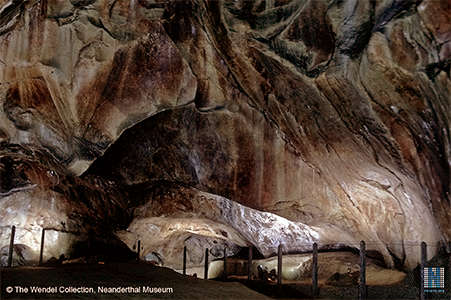
Salon Noir
La Grotte de Niaux is located in southwestern France in the northern foothills of the Pyrenees.
The Niaux Cave's system is complex and has a combined length of more than 14 km of underground passages and chambers. An archaeological site with a documented history of Paleo-human presence, Niaux contains numerous distinct areas and galleries of carefully drawn and vivid wall paintings, executed in a black-outlined style typical of the classic Magdalenian period, between 17 000 and 11 000 years ago.
Photo: Heinrich Wendel (© The Wendel Collection, Neanderthal Museum)
Text: Wikipedia
The Font de Gaume cave near Les Eyzies has a deep sack-like niche right next to a small bison-sanctuary. Here, too, a head motif pointing to 'consciousness': on the left wall of this reclining room, two human faces are painted in black, close together, in profile, looking at each other. Further representations are missing.
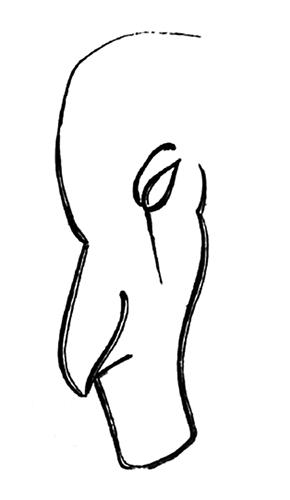
Font-de-Gaume, Salle des petits bisons. Profile of an engraved human face, drawn by H. Breuil.
Height 23 cm.
Photo: Capitan et al. (1910)
Source: Plassard (2005)
The ‘Camarin’ in the cave of Le Portel is particularly impressive. ( A Camarin is a shrine or chapel set above and behind the altar in a church, but still visible from the body of the church - Don )
A vestibule leads through a rather narrow opening into a transverse room. This small, very low room naturally depicts the larger-than-life negative of a person lying stretched out in it. If you lie down here, your head, shoulders and body are surrounded by the space. The person lying down is completely surrounded by painted images of bison, horse and ibex, long rows of dots and a sign that probably indicates bisexuality. On the left, inside the entrance, the graphically perfect image of a stag's antlers in black, points to the male principle, while below it a vagina painted in red indicates the female principle. Both principles are united in the androgynous symbol next to the reclining figure. This place with its round opening is reminiscent of both a grave and a 'uterus'.
Santimamiñe
A little-known small sanctuary in the Santimamiñe cave near Guernica in northern Spain looks like a uterus, even like the inside of an egg. Behind the right-hand barrier in the large sanctuary at the front, a short, narrow crawlway leads through a very narrow opening into a 300 cm long and 170 cm high structure, which completely resembles the inside of a lying egg. At the top, a painting in black, which has unfortunately become unrecognisable due to thick layers of calcite, indicates that this place was used during the Ice Age. The shape of the room can be recognised by lying curved in it. For a viewer inside the bare, curved room, slipping into it looks just as strange as wriggling out of it for a viewer outside the room. Both correspond to the sight of a birth.
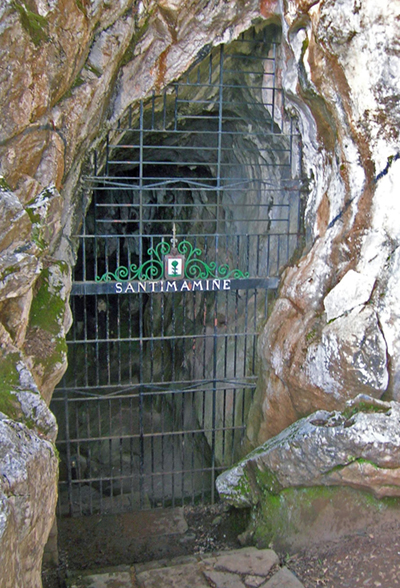
Santimamiñe cave entrance, in Kortezubi, Biscay, Spain
Photo: Javier Mediavilla Ezquibela
Permission: GNU Free Documentation License, Version 1.2 or any later version
In this context, I was reminded of Professor Marius Schneider's descriptions. During his research trips to record the 'oldest music in the world' in South Africa and Australia, he experienced initiation rites among archaic peoples. One Australian tribe combines the manhood ceremony with the ritual death and rebirth of the young person. The ritually dying person crawls into a hollow in a tree or into a hole in the ground. It signifies the interior of the 'Great Mother', as well as the graves of the dead, from which rebirth is expected. The ritual death (like the real one) is accompanied by the music of wooden didgeridoos. Then the sound of the 'buzzing wood' signals a new conception, revitalisation and finally a new birth. The 'newborn' plays the staggering gait of a small child. He staggers towards the men awaiting him. He straightens up more and more to then stand upright as a man among the men.
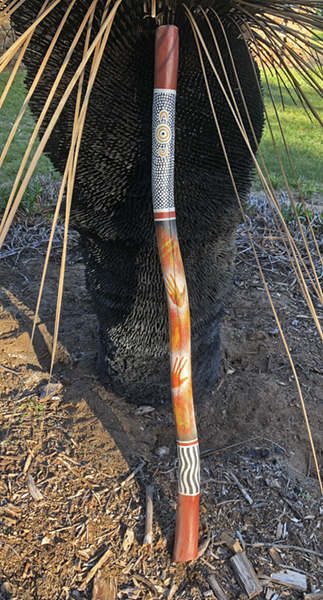
Didgeridoo
This didgeridoo was made by Mark Atkins, one of Australia’s finest didgeridoo players, and the designs on this didgeridoo include parts of his totem.
Mark Atkins is recognised internationally for his collaborative projects with some of the world’s leading composers and musicians. A descendant of Western Australia’s Yamitji people, as well as of Irish/Australian heritage, Mark Atkins is known not only for his masterly playing, but also as a storyteller, composer, percussionist, visual artist and instrument maker.
Through Mark’s lips the air blows as a natural desert sound, in old ethnic chants and in polyphonic melodies of astonishing rhythm.
The didgeridoo is classified as an end-blown straight tubular natural trumpet without mouthpiece, with a written range of typically A2 to G3.
Text: © www.mark-atkins.com and Wikipedia
Photo: Don Hitchcock 2024
Source: Private collection
Passion, death, rebirth and the awakening to the full power of life and creation as successive stages of a ritual are nowhere more evident than in the Pech Merle cave near Cabrerets. A large sanctuary shows a sloping rock and a cavity under a large calcite covered stone close together. The negative print of a left male hand is sprayed onto the upright rock in red paint, framed by large red dots. The plafond of the deep, low cavity is covered by many feminine depictions in red and brown colours. The expressive effect of this large imagining of the masculine and feminine principle is strong.
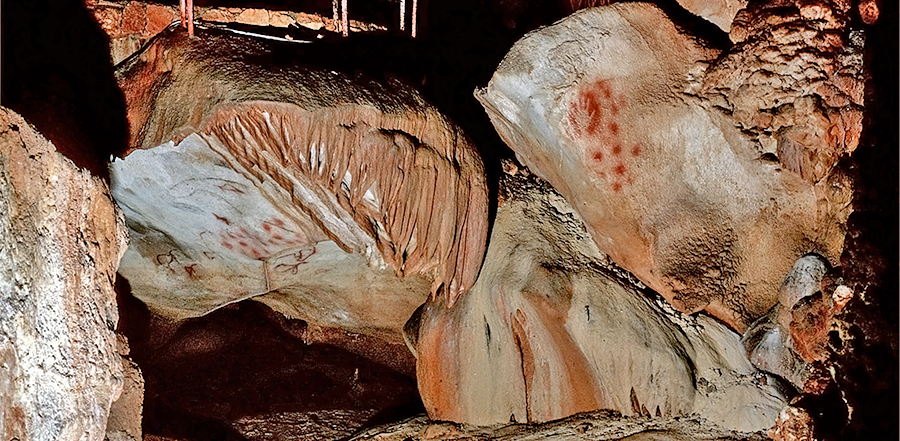
The panel of women - bison, in the Salle des Peintures
Photo: Heinrich Wendel (© The Wendel Collection, Neanderthal Museum)
Plafond des Hiéroglyphes - Hieroglyphic Ceiling.
( A plafond is an ornately decorated ceiling - Don )
On an ochre background a partial reproduction, life-sized, of a number of finger-drawings found on the cave's ceiling comprising macaroni and figurative drawings These drawings seem to belong to all periods. They were executed with one, two or three fingers on a clay surface by individuals who had climbed up on huge blocks fallen from the dome.
The same drawings have been reproduced on a smaller scale, on a white background ; some figurative drawings have been coloured:
- in green : a notched circle.
- in red : female silhouettes.
- in blue : mammoths.
Artist: Not recorded
Rephotography: Ralph Frenken 2019
Source and text: Pech Merle Museum
Above this sanctuary, one floor above, as it were, is another sanctuary. Next to a pillar made of calcite formations, the Ice Age Man painted the most impressive of all depictions of a 'spear man' ( wounded man ) on the plafond.
The figure appears to have breasts. Perhaps the small fold in the rock, albeit a little too deep, was regarded as an erect phallus. In that case, the figure would have been of two sexes.
Cougnac's androgynous ( aviform ) sign is painted right next to it, and not far from both is the image of a pregnant bison. So perhaps this composition contains references to self-generation and self-birth through a fire of life that ignites in an almost Osirian way in suffering and death.

Entrance to the Gallery of the Wounded Man. This image shows the pillar referred to above.
Photo: Heinrich Wendel (© The Wendel Collection, Neanderthal Museum)

The Wounded Man figure from Grotte du Pech-Merle, Lot. The aviform sign, and the possible breasts and penis referred to above may be seen in this image.
Click on the image to see the full size version.
Photo: Heinrich Wendel (© The Wendel Collection, Neanderthal Museum)
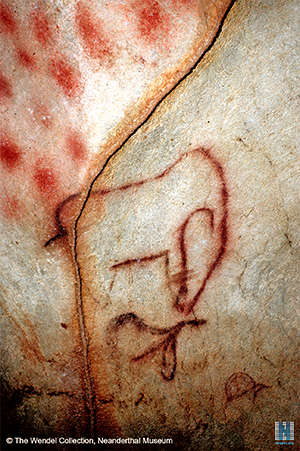
Panneau des Femmes-Bisons - some of the Femmes-Bisons.
Note in particular the outline of a mammoth, and a female/animal Femme-Bison below it.
Photo: Heinrich Wendel (© The Wendel Collection, Neanderthal Museum)
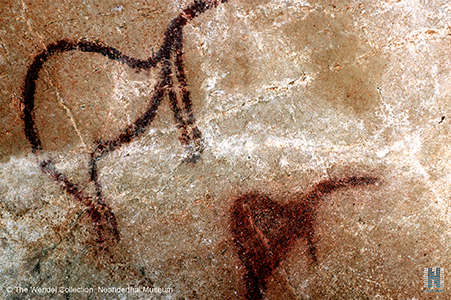
Panneau des Femmes-Bisons - some of the Femmes-Bisons.
These two images show clearly the dual animal/human nature of these figures.
Photo: Heinrich Wendel (© The Wendel Collection, Neanderthal Museum)
Le Combel is located in another part of the Pech Merle cave system. It is probably the most important Ice Age sanctuary discovered to date. It is connected to the sanctuary described above, and there is a passage between them.
Pech Merle plan
1. Possible site of the entrance at the time of the earliest decorations
2,3,4 Le Combel chamber with figures in the earliest style
5 Main decorated chamber of the early sanctuary with a frieze of horses surrounded by hand signs
6 Ossuary
7 Large black fresco most often referred to as the chapel of mammoths
8 Area with scraped ceiling
9 Figures just outside the chamber
10 Chamber with the woman/bison panel
11 Side chamber with the wounded man and Placard (or brace) sign
12 Narrow gallery with engraving of a bear and other signs
Photo: Leroi-Gourhan, in Champion et al. (2009)
If the spear man at the beginning of this corridor also indicates the beginning of a passion of ritual pain, then the picture above the entrance to the sanctuary of Combel is a meaningful conclusion to this path. It depicts a dying lioness painted in red. This looks remarkably similar to the famous lioness in the North Palace at Nineveh (now in the British Museum), except that she is about thirteen thousand years older. While she raises her head and chest with her front legs, her rear body drags paralysed on the ground. Two interestingly composed horses in the Lascaux style complete the composition.
Le Combel
A horse on the right, a cave lion on the left.
This appears to be the image referred to above as a dying lioness.
Note that the male cave lion did not have a mane, so the gender is unknown.
Photo: Heinrich Wendel (© The Wendel Collection, Neanderthal Museum)
Reign of King Ashurbanipal, 669 BC - 631 BC
Wounded Lioness as referred to above.
A lioness is shown in her death throes, struck by three arrows, one of which has caused her to lose strength in her rear legs. This superb though horrifying image is deservedly famous for its artistry, and is often reproduced.
Catalog: Gypsum alabaster, 124856
Photo: Don Hitchcock 2015
Source: Original, British Museum, http://www.britishmuseum.org/, © Trustees of the British Museum, CC BY-NC-SA 4.0
Text: Don Hitchcock
The complete panel described above, as a drawing.
Artist: Not recorded
Rephotography: Ralph Frenken 2019
Source: Pech Merle Museum
The entrance hole under this picture must also have been very narrow in earlier times, when the clay of the cave did not yet fill the adjoining crawlway. Today, the other end of this crawlway must be reached from the opposite side, from the exit. There you can see how the end of the crawlway, which eventually widens, leads into a roundish room. It is about 1 metre high and just under 2 metres in diameter. On the left, the person crawling in encounters a calcite deposit formation about 60 cm high, in the centre of which Ice Age man has apparently already seen a vagina. He has painted a large round red spot over it - emphasising the 'feminine'. This image must have been to him a 'primordial mother's womb deep inside the earth'. He was looking for this anyway when he went into a 'cave'.
Here, however, it is the 'primordial womb' in the compressed, narrow cave space, which is finally reached by crawling through the large cave, while the crawler himself becomes smaller and smaller, as it were, in the rock that surrounds him ever more closely. He, the ritually dying man, crawls back to his origin.
What does this place look like? One side of the 'vagina' formation is smoothed as if by constantly repeated touch. It can only have been a worshipping touch. Above this formation, the ceiling of this room is richly decorated with short round stalactites. They look like female breasts with maternal nipples, which the Ice Age man highlighted with black and a little red colour. This 'plafond of breasts' arches over from the 'vagina' to a picture opposite. Painted in black, the picture shows three or four intertwined strange animals. They are called 'monsters': tiny, antelope-like heads on strong necks that swing over into voluptuous, pregnant bodies. The rearmost animal body resembles Lascaux's rhinoceros. The whole thing is actually one animal. In its dynamic swinging into each other, it looks as if it is constantly giving birth to itself anew from its own eternal pregnant fullness. Perhaps it is a kind of 'primordial animal' in which the vital side of man also receives its constantly necessary regeneration.
These photographs are of the intertwined strange animals described above.
The images are very hard to interpret. It was originally thought to be of antelopes. The most likely interpretation is, however of two (or perhaps three) stylised female (or males that had shed their antlers) Megaloceros
Starting from the left, we have what appears to be the rump of an animal, with a strange shape that may be a tail.
This morphs into the body and front legs of an animal with a very small head.
The second animal, also facing right, has a strange spiky protuberance that is possibly the dark hump of a Megaloceros, followed by a neck with again an unnaturally small head.
Overlying all the images are some vertical lines, in groups of three or four, in a format usually associated with coat hair in this cave.
Altogether this is a very strange panel.
Photo: Heinrich Wendel (© The Wendel Collection, Neanderthal Museum)
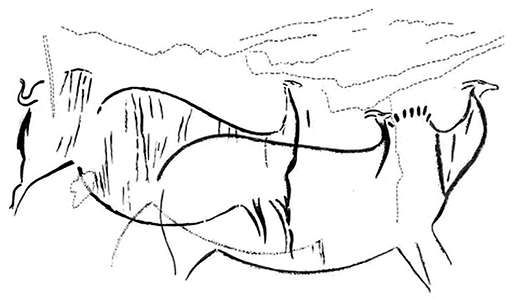
Drawing of this panel.
Photo: Lorblanchet (2010) in Lawson (2012)
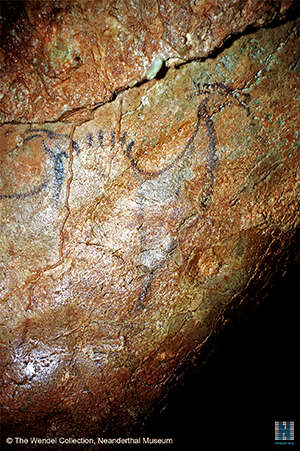
This is a closeup of the hump and head of the megaloceros on the right.
Photo: Heinrich Wendel (© The Wendel Collection, Neanderthal Museum)
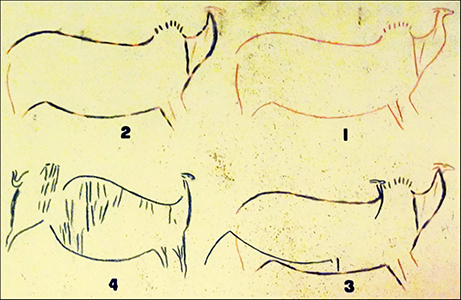
Drawings of the antelope panel.
The Museum card reads, in part:
The composition of the panel included four stages.
1. On the right, the outline in red of an animal.
2. Retouching in black of the first animal.
3. Drawing in black of the head and belly of a second animal (other parts of the drawing may have been erased by erosion).
4. Drawing in black of a third animal, its hindquarters having been drawn over a second time. The shading in vertical lines confirm that it is a single subject, despite the retracing.
These drawings are amongst the oldest in Pech Merle, dating from about 25 000 BP.
Artist: Unrecorded
Rephotography: Ralph Frenken 2019
Source: Pech Merle Museum
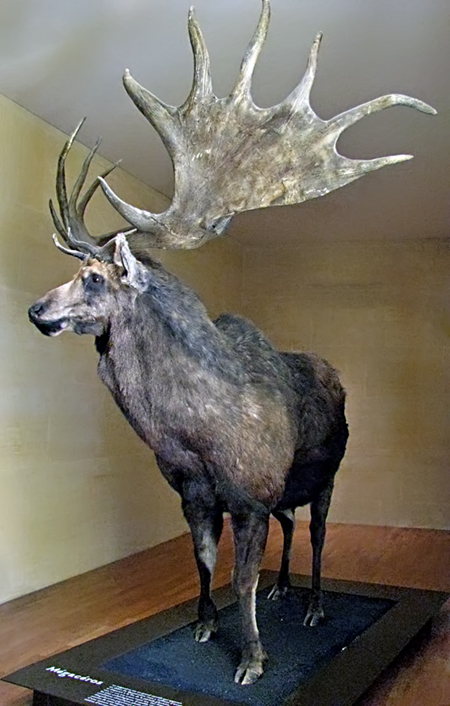
Megaloceros (listed on the display as Mégacéros) were important herbivores in Eurasia during the Ice Ages. The largest species, M. giganteus, vernacularly known as the 'Irish Elk' or 'Giant elk', is also the best known.
Most members of the genus were extremely large animals that favoured meadows or open woodlands, with most species averaging slightly below two metres at the withers. This specimen is of a male, the female did not have these huge antlers.
Text: Adapted from Wikipedia
Photo: Don Hitchcock 2008
Source: Display at Le Musée National de Préhistoire, Les Eyzies-de-Tayac
Everything in this room is 'mother'. This made me think of the egg room in Santimamiñe. Here, however, man himself has worked much more intensively alongside nature - in nature - to create the place of his own mystery. In this room, you can only lie bent over like an embryo. The one who lay down here like this was previously looking for the entrance to this centre of life under the image of the dying lioness. Could he possibly have been the 'spear man' - a person who, as a sign of mortality and vulnerability, had spears of death ritually stuck under his skin and who, after passing the test, bleeding - in his experience close to death - found the entrance to the place of reborn fullness of life under the image of the dying lioness?
The continuation of the images and spaces makes everything even clearer. Right next to the 'rock vagina', behind the head of the person lying bent over, is the exit from this 'womb'. It leads into the next room. Those who squeeze through this narrow, angled channel really do appear to the viewer at the other end like a being labouring to give birth from a maternal - stone - shell.
The 'newborn' sees a composition painted in red above him, which shows a shape made up of small (one might say 'masculine') dots in a half-enclosing shape made up of large ('feminine') dots. One can also assume that this is an image of the birth of the son from the mother as well as an image of conception.
The 'newborn' enters a hall almost 2 metres high. Immediately to his right is a column formed when a stalactite and stalagmite have joined. A shallow niche with a diameter of 60 cm arches over the column. Many red dots have been arranged around a natural formation that looks like a mature, nourishing woman's breast. It has been faintly coloured. One involuntarily thinks that the 'newborn' must be nourished. A long row of large, mostly red dots runs to the left towards the exit from this hall. Above the exit, on the ceiling, there is another large composition of red dots similar to the previous one.
From here, a path curving to the left leads over scree and collapsed spaces to a passage that is narrowed on the right by a vertical calcite deposit formation about 120 cm in size. It is a horn-shaped stalagmite that becomes straighter towards the top and grows out of the side of the rock. The upper end has been artificially worked to make the formation appear clearly as a large erect phallus. To the left, opposite the phallus, there is an engraving in a niche. It seems to me to show quite clearly a man embracing a huge phallus. Like the image of the spear man, perhaps this image also expresses the corresponding cultic action in the appropriate place. Perhaps it was intended to restore the 'tormented', then the 'dead', then the 'buried', the 'newly conceived', the 'newly born', the 'nourished and gradually maturing' and finally the full creative male vigour, to a new, more knowledgeable life. - Under a low rocky roof, an arduous path leads to the exit from the extensive sanctuary. The exit is right next to the entrance. The whole thing was a tour.
After this consideration of Ice Age sanctuaries, let us take a look at the sanctuaries of ancient Egypt: on the basis of the room layout and the grave goods in the tomb of Tut-Anch-Amun ( Tutankhamun ), Desroches Noblecourt explains the pharaohs' tombs as places of 'rebirth'. However, these are tombs of the deceased; the aforementioned sanctuaries were also 'tombs' in a certain sense, but for the living. Egypt also has tombs in which no dead person was ever buried. The most famous is the 'Osireion', directly behind the temple of Seti I at Abydos (circa 1310 BC, 19th Dynasty).
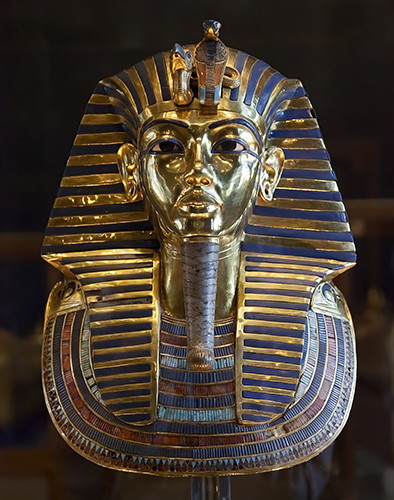
Eighteenth Dynasty: 1 550 BC - 1 292 BC
Tutankhamun
The 1922 discovery by Howard Carter of Tutankhamun's nearly intact tomb, funded by Lord Carnarvon, received worldwide press coverage. It sparked a renewed public interest in ancient Egypt, for which Tutankhamun's mask, now in the Egyptian Museum, remains the popular symbol. Exhibits of artefacts from his tomb have toured the world. In February 2010, the results of DNA tests confirmed that he was the son of the mummy found in the tomb KV55, believed by some to be Akhenaten. His mother was his father's sister and wife, whose name is unknown but whose remains are positively identified as 'The Younger Lady' mummy found in KV35. The 'mysterious' deaths of a few of those who excavated Tutankhamun's tomb have been popularly attributed to the curse of the pharaohs.
Since January 1, 2016 it is possible again to take photographs in the Egyptian Museum in Cairo. The funerary mask of Tutankhamun is certainly the most popular exhibit.
Catalog: JE 60672
Photo: Roland Unger, GNU Free Documentation License, Version 1.2
Source and text: Cairo Museum, Wikipedia
The mask is 540 mm tall, 393 mm wide and 490 mm deep. It is fashioned from two layers of high-carat gold, varying from 1.5 to 3 mm in thickness, and weighing 10.23 kg (22.6 lb). X-ray crystallography has revealed that the mask contains two alloys of gold: a lighter 18.4 karat shade for the face and neck, and 22.5 karat gold for the rest of the mask.
This mask of Tutankhamun is an example of the highest artistic and technical achievements of the ancient Egyptians in the New Kingdom. Covering the head of the wrapped mummy in its coffin and activated by a magical spell, no.151b from the Book of the Dead, the mask ensured more protection for the king's body.
The exact portrayal of the king's facial features achieved here made it possible for his soul to recognise him and return to his mummified body, thus ensuring his resurrection. The head is covered by the royal headdress and the forehead bears the emblems of kingship and protection: the vulture and uraeus, or cobra.
The gold sheets used in this wonderful mask are joined together by heating and hammering. The eyes are of obsidian and quartz and the eyebrows and eyelids are inlaid with lapis lazuli. The broad inlaid collar of semiprecious stones and coloured glass ends in falcon heads.
The face represents the pharaoh's standard image, and the same image was found by excavators elsewhere in the tomb, in particular in the guardian statues. He wears a 'nemes' headcloth, topped by the royal insignia of a cobra (Wadjet) and vulture (Nekhbet), symbolising Tutankhamun's rule of both Lower Egypt and Upper Egypt respectively.
The ears are pierced to hold earrings, a feature that appears to have been reserved for queens and children in almost all other surviving ancient Egyptian works of art. It contains inlays of coloured glass and gemstones, including lapis lazuli (the eye surrounds and eyebrows), quartz (the eyes), obsidian (the pupils), carnelian, feldspar, turquoise, amazonite, faience and other stones (as inlays of the broad collar).
When it was discovered in 1925, the 2.5 kg narrow gold beard, inlaid with blue lapis lazuli, giving it a plaited effect, had become separated from the mask, but it was reattached to the chin using a wooden dowel in 1944.
In August 2014, the beard fell off when the mask was taken out of its display case for cleaning. The museum workers responsible used quick-drying epoxy in an attempt to fix it, leaving the beard off-centre. The damage was noticed in January 2015, and has been repaired by a German-Egyptian team who reattached it using beeswax, a natural material used by the ancient Egyptians.
Additional text: http://www.globalegyptianmuseum.org/record.aspx?id=15062
According to contemporary reports, the Osireion, which is now open at the top, was underground. A hill had been artificially heaped up above it and planted with lush vegetation. In the midst of the surrounding desert, it resembled an island of life.
A shaft leads down to a long underground corridor that meets the western head of the Osireion. Pictures painted somewhat later from the 'Guides to the Afterlife' - on the left from the 'Book of the Gates', on the right from the 'Book of What is in the Underworld (Amduat)' - cover the walls of the passageway. The living man, who was to be ritually buried here, saw in passing what experiences awaited him in the 12 hours of the night of death. Here too, in the third hour of the book 'Amduat', the head of the 'Radiant One' is missing (which perhaps replaces the missing sun god in the third barque and thus represents the deceased himself).
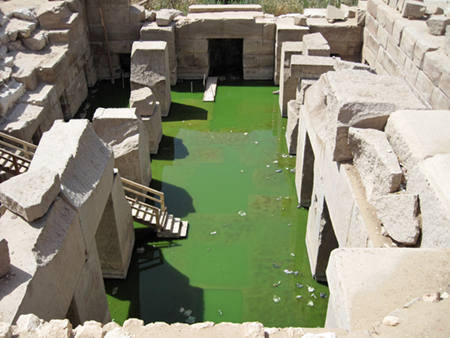
The Osireion
The Osireion is part of the Temple of Seti I's complex. It may have been built to resemble the tombs in the Valley of the Kings. It is located centrally behind the main part of the Temple of Seti I along an east west axis. Most of its structure would have been subterranean. It was built at a considerably lower level than the foundations of the Temple of Seti I. However, most of the roof has been lost. There is an entrance tunnel that runs along a north south axis behind the Osireion's central hall. It is 69 metres long and stone lined.
Photo: Olaf Tausch
Permission: GNU Free Documentation License, Version 1.2 or any later version
In the 'Book of the Dead', the deceased begs for his head, the continuous possession of which he ultimately demands as a god from the gods. The image of the last (12th) hour finally shows the sunrise, the birth, at the end of all death trials. Here, at this site, where the long corridor leads into the Osireion, the 12th hour is not only painted as 'sunrise'. The modified picture also shows the sunrise as the first appearance of the sun on the morning of creation. According to the ancient Egyptian creation myth, a hill rose from the primordial waters of the 'Nun' (see hill above the Osireion). The hill opened up and the sun barque emerged from it. Here the mound is personified as a god who carries the sun barque upwards. In it, as one of nine gods, 'Ra' illuminates the world for the first time. Ra is depicted as the beetle 'Chepre', i.e. as the immutable one who creates himself in all transformations through death and birth. Light here is primordial light, illuminating the examinee when he has passed through death. - The path continues into the actual Osireion. It is symmetrically flanked at the front and rear (west and east) by two halls. Like the entire Osireion, the halls are exceptionally built in the style of the pyramids that are over a thousand years older and look like the royal coffin chamber in the Pyramid of Chefren.
We do not know what happened to the examinee in this first hall. Only conjecture helps here, supported by later wall paintings in a small anteroom of the Osireion and also by paintings in rooms of the Hathor temple at Dendera, which were probably erected for a similar purpose. (It is noteworthy that the entire complex of the Osireion was originally just as 'silent' - so devoid of any images and writings - as the complexes of the pyramid buildings in the 4th Dynasty).
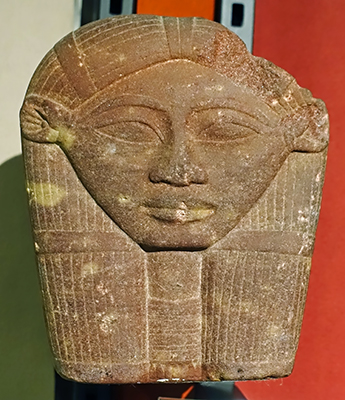
Nineteenth - Twentieth Dynasty: 1 292 BC - 1 077 BC
Head of the goddess Hathor.
Catalog: Red sandstone, Inv. Nr. 1935.200.123
Photo: Don Hitchcock 2018
Source and text: Original, Museum August Kestner, Hannover
It can be assumed that in this place the examinee experienced death through some kind of ritual. Perhaps he was wrapped in mummy bandages after his internal organs were symbolically removed from him in the form of large amulets that had clothed him. The contents of his consciousness probably gradually disappeared with them. Analogous to a real occupation, these amulets, which represented the organs, were then buried in the traditional four canopic jars in the canopic jar shrine.
A short corridor leads from this place further east into the central sanctuary. A rectangular island in the centre of the large room is completely surrounded by water. This is certainly intended to represent the island of creation surrounded by the 'Nun'. Two stairways lead west and east out of the water onto the island, on which stand ten square granite columns that once supported the corbelled vault. In the centre of the island, at the point from which the sun barque was to rise on the day of creation, there is a rectangular opening in the floor, suitable for holding a sarcophagus or a bier. Almost adjacent to this opening, further to the east, there is an almost square opening in the floor that could accommodate a representative canopic shrine. Did people perhaps wait here in these niches after the burial of the examinee until the sun of enlightenment actually rose from the 'dead man' in mystical union with the All-God? - If so, the world would have been created anew in this person who had lived through death, and the green hill of the world's birth would rightly rise above this place of death.
The second hall, which adjoins the central sanctuary across the water to the east, may have served to 'unbind' the ritually mummified person. Perhaps the texts that we know from the walls of the coffin chambers in the pyramids of the late Fifth and Sixth Dynasties were heard here: 'Your bandages are loosened. You are not dead... Move your limbs, O god! As a god you appear before all the gods.... .'
He has now become an 'Osiris'; the god who 'passed through death' two thousand years before Christianity. Originally, Osiris was a god of vegetation who died again and again (like the seed) so that new life could germinate from his corpse (the fallow earth). The sheaf of grain thus became a symbol of 'duration' and was associated with Osiris, because the repeated death of the god as the origin of life is decided in life itself.

21st - 25th Dynasty: 1 077 BC - 656 BC
Osiris
Circa 1 000 BC - 700 BC
Osiris' scourge and the crosier are attributes of rulers. The myth of death and resurrection of the god expresses the hope of renewal of life.
Bronze, face with gold plating.
Catalog: Bronze, Inv. H 568
Photo: Don Hitchcock 2015
Source and text: Badisches Landesmuseum Karlsruhe Germany
Perhaps we are not only dealing with the 'mock tombs' of Egypt, but also with the possibly similar internal sanctuaries of the Ice Age, places where a primitive religion knew more about the connection between death and birth than we think possible. It would have been a religion 'without doctrine'. Their cult would have been their mysticism and their mysticism would have been nature itself.
When researching megalithic cultures, one should also keep an eye out for possible ritual sites of a similar kind.
Heinrich Wendel, Düsseldorf
Text auf Deutsch:
Heinrich WENDEL, Düsseldorf
EISZEITLICHE UND ALTÄGYPTISCHE SANKTUARE, GESEHEN ALS ORTE EINER WIEDERGEBURTS-RELIGION
Anläßlich der Halleiner Tagung des I.C. im Mai 1974 hielt H. Wendel, von dem viele Fotos in den Felsbilder-Werken von Herbert KÜHN stammen, einen eindrucksvollen Vortrag, der sich durch seine spekula- tiv wirkende Synthese von den üblichen deskriptiven und dokumentierenden Bearbeitungen der Felskunst unterschied. Obwohl die Verifizierung der Ansicht des Autors weitgehend unmöglich sein dürfte, verdient die Gesamtschau — bei allen nötigen Vorbehalten gegenüber einer sehr weitgehenden subjektiven Deutung — Respekt und Beachtung. Wichtig ist der Gesichtspunkt, daß die gesamte Umwelt der Höhlenkunst betrachtet werden sollte — nicht nur isoliert heraus fotografierte Bilder, die in dieser Form noch nichts über mögliche innere Zusammenhänge aussagen. - H. B.
In den mit Malereien, Gravierungen und Zeichen versehenen Höhlen der Eiszeit fallen besondere kleine Sanktuare auf. Nur ein einzelner Mensch kann ausgestreckt oder gekrümmt in ihnen liegen. Die Räumlichkeit dieser Sanktuare ist im Felsgestein der Höhlen nicht etwa vom eiszeitlichen Menschen geschaffen oder von ihm mit Hammer und Meißel auch nur im geringsten für seine Zwecke hergerichtet worden. Er nahm sie so, wie die Natur sie ihm bot und schlug höchstens einige Stalaktiten weg. Aber er gestaltete sie mit Bildern und Zeichen aus, die uns heute auf die Bedeutsamkeit hinweisen, welche diese „Kammern“ für den kultischen Gebrauch des Eiszeit- menschen gehabt haben können.
Die Höhle COUGNAC bei Gourdan enthält ein kleines Sanktuar, der 'Sack' genannt, in welchem ein Mensch ausgestreckt liegen kann. Daß dieser mit dem Höhlenboden ebene Raum für den Eiszeitmenschen eine Bedeutung hatte, bestätigen einige Punkte und Zeichen, die er im Innern an die Wände malte. Rechts über dem Einschlupf befindet sich eine große Malerei, die das Ende eines von links her die Wände bedeckenden Bilderzyklus zu sein scheint. Sie stellt eine Mammut- komposition dar: Genau parallel zu einer reinen Naturbildung in der Wand, in welche ein Mammut hineingesehen werden kann — was der Eiszeitmensch mit einigen unterstützenden Linien (Zähne) bestätigt hat — wurde komplett in roter Farbe ein kleineres Mammut hinein gemalt. In den sich überdeckenden Köpfen dieser Mammutbilder ist mit schwarzer Farbe ein Mensch dargestellt. Sein Kopf, exakt im Zentrum, der Mammutköpfe, trägt eine vogelähnliche Tiermaske. Sein Körper ıst mit Pfeilen bedeckt. Rechts von ihm fällt eine zweite, schwer erkennbare menschliche Gestalt in hellbrauner Farbe erst später auf. Sie ist wie stürzend gemalt, als fiele sie aus dem Mammutkopf heraus. Auch sie ist mit Pfeilen und vielleicht auch mit Maske versehen.
In den „vorangehenden“ Bildern, einige Meter nach links, ist eine weitere menschliche Dar: lung zu sehen. Deutlich, in schwarzer Farbe, hebt sie sich aus der Brust eines rot gemalten Tierbildes heraus, das einem Elch mit großem Geweih ähnlich sieht. Die Gestalt ist ebenfalls mit Pfeilen versehen. Aber ihr fehlt der Kopf.
Am Beginn des „Bilderzyklus‘“‘ zeigen zwei kleinere Nischen mehrere Variationen eines Zeichens, welches in der Höhle PECH MERLE (siehe weiter unten) in noch engerem Zusammen- hang mit dem „Pfeil-Menschen“ wiederkehrt:
294
Nach vielen Vergleichen eiszeitlicher Zeichen hinsichtlich ihres Geschlechtsbezuges möchte ich dieses Zeichen dem „Doppelgeschlechtlichen‘ zuordnen.

In beiden Bildern fällt die mehrfache und verschiedenartige Betonung der Kopfregion, die wohl auch vom Eiszeitmenschen maßgebend für das Bewußtseinserlebnis galt, und die Steigerung der Bilder bis hin zum Einmann-Liegeraum auf. Das öfters wiederkehrende Bild des „Pfeilmenschen“ darf wohl kaum als Exekutionsdarstellung angesehen werden.
Einen schon als liegend abgebildeten Menschen mit Vogelmaske, mit wie erstarrten Gliedern und erigiertem Phallus, zeigt das als „Krypta“ bezeichnete Sanktuar in der Höhle von LASCAUX. Der tief unter dem Gesamthöhlen-Niveau gelegene Raum macht eine liegende Haltung in ihm nicht nötig. Er ist hoch, schmal und langgestreckt. Den Hinweis auf „liegen“ gibt das Bild selbst, das hier als einziges diesen Ort beherrscht. Dem vogelköpfigen Menschen fehlen die Pfeile. Dafür steht neben ihm ein Bison, dessen ganzer Körper, diagonal von einer Lanze durchstoßen, den aufge- rissenen Bauch zeigt, der seine Eingeweide ausschüttet. Der Kopf des Bisons wendet sich um in die Schußrichtung. Vogelmakse und erigierter Phallus des liegenden Menschen schließen aus, daß dieser als Opfer des todeswütigen Bisons zu einer Jagdszene gehört. Einige Striche — vielleicht zerbrochene Lanzenteile — und ein auf dem oberen Ende einer Stange sitzender Vogel komplettieren den rechten Bildteil. Der linke Teil wird von einem, auffällig in späterem Stil gemalten, davon- eilenden Nashorn und zwei Punktgruppen eingenommen. Diese „Szene von Lascaux“ wurde unter anderem als quasi schamanischer Vorgang gedeutet. Das müßte noch nicht einmal so fernliegend sein, gerade wenn man die Szene von einigen Details ausgehend beurteilt. Vogelmaske, Stangen- vogel und liegende erstarrte Haltung des Menschen mit erigiertem Phallus können auf Bewußt- seins-Veränderung hinweisen. Desgleichen kann der so grausam getroffene Bison in Beziehung zu den hier fehlenden Pfeilen im Menschenleib des Liegenden stehen.
Einen weiteren „Pfeilmenschen“ in Verbindung mit einer Liegestätte entdeckte ich rechts nahe dem Ende des „Divertikels“ im hintersten Teil der Höhle ALTAMIRA. Eine Naturbildung an der niedrigen Wand des nur kriechend zu erreichenden Ortes kann mit wenig Phantasie als plastisches Negativ einer ca. 30 cm hohen menschlichen Gestalt angesehen werden. Der Eiszeitmensch sah sie so an, denn er ergänzte sie an ihrer rechten Seite mit schwarz gemalten Pfeilen.
Eine andere, naturgebildete „negative Plastik“ wurde vom Eiszeitmenschen durch schwarze gemalte Geweihe ergänzt. Sie sieht aus wie der Negativ-Abdruck eines Antilopen-Kopfes. Dieses Gebilde befindet sich in der Höhle NIAUX in der, von rechts gezählt, vierten Bildernische des „Schwarzen Saales“. Diese Nische erstreckt sich am weitesten in die Felswand hinein und wird hinten durch eine Aushöhlung fortgesetzt. Über ihr erscheint, neben einer Bisonmalerei, jener Antilopenkopf. Links in dieser Aushöhlung ist mit schwarzer Farbe eine vornübergebeugte menschliche Gestalt ohne Kopf gemalt. Sie scheint einen erigierten Phallus zu tragen. Pfeile fehlen hier. Die ursprünglich extreme Niedrigkeit dieses Raumes bestimmt ihn zur Liegestätte.
Eine tiefe sackähnliche Nische, direkt neben einem kleinen Bison-Saktuar, zeigt die Höhle FONT DE GAUME bei Les Eyzies. Auch hier wieder ein auf „Bewußtsein“ hinweisendes Kopf-Motiv: auf der linken Wand dieses Liegeraumes befinden sich mit schwarzer Farbe dicht nebeneinander zwei menschliche Gesichter, im Profil gemalt, die einander ansehen. Weitere Darstellungen fehlen.
Besonders eindrucksvoll ist das „Camarin“ in der Höhle LE PORTEL. Ein Vorsaal führt durch eine ziemlich enge Öffnung in einen quer gelegenen Raum. Dieser kleine, sehr niedrige Raum bildet von Natur aus das überlebensgroße Negativ eines ausgestreckt in ihm liegenden Menschen ab. Wenn man sich hier hineinlegt, werden Kopf, Schultern und Körper wunderbar passend von dem Raum umwölbt. Der Liegende wird völlig von gemalten Bildern, von Bison, Pferd und Steinbock, von
295
langen Punktereihen und von einem Zeichen umgeben, welches wohl auf Zweigeschlechtlichkeit hinweist. Links an der Innenseite des Eingangs deutet das grafisch vollkommene Bild eines Hirschgeweihes in schwarzer Farbe auf das männliche Prinzip, während darunter eine rötlich gemalte Vagina auf das weibliche deutet. Beide Prinzipe sind in dem androgynen Symbol neben dem Liegenden vereinigt. Dieser Ort mit seiner runden Öffnung erinnert ebenso an ein Grab als auch an eine „Gebärmutter“.
Wie eine Gebärmutter, ja sogar wie das Innere eines Eies sieht ein unbekanntes kleines Sanktuar aus, u.zw. in der Höhle SANTIMAMIÑE bei Guernica in Nordspanien. Hinter der rechten Absperrung im vorderen großen Sanktuar führt ein kurzer, schmaler Kriechgang durch engste Öffnung in ein ca. 3m langes und ca. 1,70 m hohes Raumgebilde, das völlig dem Inneren eines Liegenden Eies gleicht. Oben weist eine leider durch starke Übersinterung unkenntlich gewordene Malerei in Schwarz auf eiszeitlichen Gebrauch dieses Ortes hin. Der Form des Raumes wird man gerecht, wenn man gekrümmt in ihm liegt.
Für einen Betrachter innerhalb des kahlen ringsherum gewölbten Raumes sieht das Einschlüpfen in ihn ebenso eigenartig aus wie das Sichherauswinden aus ihm für einen Betrachter außerhalb des Raumes. Beides entspricht dem Anblick einer Geburt.
Ich mußte in diesem Zusammenhang an die Schilderungen von Prof. Marius Schneider denken. Aus seinen Forscherreisen zur „Ältesten Musik der Welt‘ in Südafrika und Australien erlebte er Einweihungsriten bei archaischen Völkern. Ein australischer Volksstamm verbindet die Mannbar- keits-Feier mit rituellem Tod und Neugeburt des Jugendlichen. Der rituell Sterbende kriecht in eine Baumhöhlung oder in ein Loch im Boden. Es bedeutet das Innere der ‚Großen Mutter“, ebenso wie die Gräber der Toten, aus denen Wiedergeburt erwartet wird. Der rituelle Tod wird (wie der echte) von Musik der Holztrompeten begleitet. Dann gibt der Klang des „Schwirrholzes“ das Zeichen für neue Konzeption, für Neubelebung und schließlich für die Neu-Geburt. Der „Neugeborene“ spielt das Torkeln eines kleinen Kindes. Er wankt den ihn erwartenden Männern entgegen. Er richtet sich mehr und mehr auf, um dann aufrecht als Mann unter die Männer zu treten.
Passion, Tod, Neugeburt und das Erwachen zur Erlangung der vollen Lebens- und Schöpferkraft als aufeinander folgende Stationen eines Rituals werden nirgendwo so deutlich als in der Höhle PECH MERLE bei Cabrerets.
Ein großes Sanktuar zeigt dicht nebeneinander einen schräg aufgerichteten Felsen und eine Höhlung unter einem großen übersinterten Stein. Auf den aufrechten Felsen ist mit roter Farbe der Negativ-Abdruck einer linken männlichen Hand aufgespritzt, umrahmt von großen roten Punkten. Den Plafond der tiefen, niedrigen Höhlung überdecken viele feminine Darstellungen in roter und in brauner Farbe. Die Ausdruckswirkung dieser großen Imagination des maskulinen und femininen Prinzips ist stark.
Oberhalb dieses Sanktuars, gleichsam ein Stockwerk darüber, befindet sich ein anderes Heiligtum. Neben einer Säule aus Sinterbildungen malte der Eiszeitmensch an den Plafond die eindrucksvollste aller Darstellungen eines „Pfeilmenschen‘“. Die Gestalt scheint Brüste zu haben. Vielleicht wurde die kleine Falte im Gestein, allerdings etwas zu tief sitzend, als erigierter Phallus angesehen. Dann wäre die Gestalt doppelgeschlechtlich. Das androgyne Zeichen von COUGNAC ist gleich neben ihr gemalt, und unweit von beidem befindet sich das Bild eines trächtigen Bisons. Vielleicht also enthält diese Komposition Hinweise auf Selbsterzeugung und Selbstgeburt durch ein Lebensfeuer, daß sich geradezu osirianisch in Leiden und Tod entzündet.
An einem anderen Platz des Höhlensystems von PECH MERLE befindet sich LE COMBEL. Es ist wohl das bedeutendste eiszeitliche Heiligtum, das bis heute entdeckt wurde. Vielleicht steht es sogar mit dem vorangehend beschriebenen Sanktuar in einem Zusammenhang, und den Abstand beider sollte ein stationenhafter Gang ausfüllen. Wenn am Beginn dieses Ganges der „Pfeilmensch zugleich den Beginn einer Passion ritueller Schmerzen andeutet, so beschließt diesen Weg sinnvoll das Bild über dem Eingang in das Sanktuar von COMBEL. Es stellt eine in roter Farbe gemalte sterbende Löwin dar. Sie sieht der berühmten Löwin in dem Nordpalast zu Niniveh (jetzt Britisches Museum) erstaunlich ähnlich, nur ist sie etwa dreizehntausend Jahre älter.
296
Während sie Kopf und Brust mit den Vorderbeinen hochstemmt, schleift ihr hinterer Leib gelähhmt am Boden. Zwei für das Sinnbild interessant komponierte Pferde im Lascaux-Stil komplettieren die Komposition.
Das Eingangsloch unter diesem Bilde muß auch früher sehr eng gewesen sein, als der Höhlenlehm noch nicht den anschließenden Kriechgang ausfüllte. Das andere Ende dieses Kriechganges muß heute von der entgegengesetzten Seite, vom Ausgang her, erreicht werden. Dort sieht man, wie das schließlich breiter werdende Ende des Kriechganges in einen rundlichen Raum mündet. Er ist ca. 1 m hoch und hat knapp 2 m Durchmesser. Der Hereinkriechende trifft zur Linken auf eine etwa 60 cm hohe Sinterbildung, in deren Zentrum offenbar schon der Eiszeitmensch eine Vagina hineingesehen hat. Große rote runde Flecke hat er über sie hinweggemalt — das „Feminine“ hervorhebend. So wird ihm dieses Bild „Urmutter-Schoß tief im Innern der Erde“ gewesen sein. Diesen suchte er ohnehin, wenn er in eine „Höhle“ ging. Hier aber ist es der „Urschoß“ im verdichteten engen Höhlenraum, der im Gang durch die große Höhle, schließlich kriechend erreicht wird, während der Kriechende selbst gleichsam immer kleiner wird in dem Gestein, das ihn immer enger umgibt. Er, der rituell Sterbende, kriecht in seinen Ursprung zurück. Wie sieht nun dieser Ort aus?
Die eine Seite der „Vagina“-Bildung ist wie durch ständig wiederholte Berührung geglättet. Es kann wohl nur verehrende Berührung gewesen sein. Über diesem Gebilde ist der Plafond dieses Raumes reich mit kurzen runden Stalaktiten behangen. Sie sehen wie weibliche Brüste mit mütterlichen Brustwarzen aus, die der Eiszeitmensch mit schwarzer und ein wenig roter Farbe hervorhob. Dieser „Plafond der Brüste“ wölbt sich von jener „Vagina“ zu einem gegenüberliegenden Bild hinüber. In schwarzer Farbe gemalt zeigt das Bild drei bis vier ineinander verschlugene seltsame Tiere. Sie werden „Monster“ genannt: winzige, antilopenähnliche Köpfe an starken Hälsen, die in üppige trächtige Leiblichkeit hinüberschwingen. Der hinterste Tierleib ähnelt dem Rhinozeros von LASCAUX. Das Ganze ist eigentlich ein Tier. In seinem dynamischen Ineinander-Schwingen sieht es aus, als gebäre es sich selbst immer wieder neu aus seiner eigenen ewigen trächtigen Fülle. Vielleicht ist es eine Art „Ur-Tier“, in dem auch die vitale Seite des Menschen ihre beständig notwendige Regeneration erhält.
Alles in diesem Raum ist „Mutter“. Ich mußte hier an den Ei-Raum von SANTIMAMIÑE denken. Hier jedoch hat der Mensch selbst viel intensiver neben der Natur — in der Natur mitgewirkt, um sich den Ort des eigenen Mysteriums zu schaffen.
In diesem Raum kann man eigentlich nur gekrümmt wie ein Embryo liegen. Jener, der sich hier nun so hinlegte, suchte vorher unter dem Bilde der sterbenden Löwin den Eingang in dieses Lebenszentrum. Sollte er womöglich der „Pfeilmensch‘“ gewesen sein — ein Mensch, dem man zum Zeichen der Sterblichkeit und Verwundbarkeit rituell Pfeile des Todes unter die Haut spießte und der, nachdem er die Prüfung bestand, blutend — in seinem Erleben todesnahe — unter dem Bilde der sterbenden Löwin den Eingang zum Ort wiedergebärender Lebensfülle fand?
Die Fortsetzung der Bilder und Räume macht alles noch deutlicher.
Gleich neben der „Fels-Vagina“, hinter dem Kopf des gekrümmt Liegenden, befindet sich der Ausgang aus dieser „Gebärmutter“. Er führt in den nächsten Raum. Wer sich durch diesen engen, abgewinkelten Kanal zwängt, erscheint für den Betrachter am anderen Ende wirklich wie ein sich mühsam aus mütterlicher — aus steinerner — Hülle gebärendes Wesen.
Der „Neugeborene“ sieht über sich eine rot gemalte Komposition, die eine Form aus kleinen (man sagt „maskulinen“) Punkten in einer sie halb umschließenden Form aus großen („femi- ninen“) Punkten zeigt. Man kann hier ebenso ein Bild der Geburt des Sohnes aus der Mutter als auch ein Bild der Zeugung vermuten.
Der „Neugeborene“ tritt in eine knapp 2 m hohe Halle ein, Gleich rechts von ihm befindet sich eine Säule, in welcher Stalaktit und Stalagmit zusammengewachsen sind. Über die Säule wölbt sich eine flache Nische von ca. 60 cm Durchmesser. Viele rote Punkte wurden hinweisend um eine Naturbildung angeordnet, die wie eine reife, nährende Frauenbrust aussieht. Sie wurde schwach getönt. Unwillkürlich denkt man daran, daß der „Neugeborene“ genährt werden muß. Eine lange
297
Reihe großer, meist roter Punkte läuft zur Linken dem Ausgang aus dieser Halle zu. Über dem Ausgang befindet sich am Plafond wieder eine große Komposition aus roten Punkten, die der vorigen ähnlich sieht.
Von hier aus führt ein nach links gekrümmter Weg über Geröll und verstürzte Räume zu einer Passage, die zur Rechten durch eine etwa 1,20 m große, vertikale Sinterbildung verengt wird. Es ist ein hornartig geformter, nach oben hin gerade werdender Stalagmit, der seitlich aus dem Felsen wächst. Das obere Ende ist künstlich bearbeitet, um das Gebilde deutlich als großen erigierten Phallus erscheinen zu lassen. Zur Linken, dem Phallus gegenüber, befindet sich in einer Nische eine Gravierung. Mir scheint sie ziemlich deutlich einen Menschen zu zeigen, der einen riesigen Phallus umarmt. Wie das Bild des Pfeilmenschen drückt vielleicht auch dieses Bild am entsprechenden Ort die entsprechende kultische Handlung aus. Vielleicht sollte sie dem der Reihe nach zuerst den „Gepeinigten“, dann „Gestorbenen‘“, dann „Begrabenen‘“‘, „Neu-Konzipierten“, „Neu-Geborenen“, „Genährten und allmählich Reifenden“ und schließlich die volle schöpferische Manneskraft wiedergeben, zu neuem wissenderem Leben. — Unter niedrigem Felsdach führt ein beschwerlicher Weg zum Ausgang aus dem umfangreichen Heiligtum. Der Ausgang liegt direkt neben dem Eingang. Das Ganze war ein Rundgang.
Nach dieser Betrachtung eiszeitlicher Heiligtümer ein Blick auf die Sanktuare des alten Ägypten: aufgrund der Raum-Aufteilung und der Grabbeigaben im Grabe des Tut-Anch-Amun erklären die Arbeiten DESROCHE-NOBLECOURTS die Pharaonengräber als Stätten der „Neugeburt“. Hier handelt es sich aber um Gräber Verstorbener. Die vorerwähnten Heiligtümer sind im gewissen Sinn auch „Gräber“ gewesen, jedoch für Lebende. Ägypten weist ebenfalls Gräber auf, in welchen nie ein Toter beigesetzt wurde. Das berühmteste ist das „Osireion“, unmittelbar hinter dem Tempel Seti I. zu Abydos (ca. 1310 v. Chr., 19. Dynastie).
Das heute nach oben offene Osireion lag nach zeitgenössischen Berichten unter der Erde. Ein Hügel war darüber künstlich aufgeschüttet und üppig bepflanzt worden. Dieser glich inmitten der umgebenden Wüste einer Insel des Lebens.
Ein Schacht führt hinunter zu einem unterirdischen langen Gang, der auf den westlichen Kopfteil des Osireions stößt. Etwas später gemalte Bilder aus den „Jenseitsführern“ — links aus dem „Pfortenbuch“, rechts aus dem „Buch von dem, was in der Unterwelt ist (Amduat)“ überziehen die Wände des Ganges. Der Lebende, der hier rituell begraben werden sollte, sah im Vorbeigang, welche Erlebnisse ihn in den 12 Stunden der Todesnacht erwarten. Auch hier, in der dritten Stunde des Buches „Amduat“, fehlt der Kopf des „Strahlenden“, (der in der dritten Barke vielleicht den fehlenden Sonnengott ersetzt und damit den Verstorbenen selbst repräsentiert). Im „Totenbuch“ fleht der Verstorbene um seinen Kopf, dessen kontinuierlichen Besitz er schließlich als Gott von den Götten fordert. Das Bild der letzten (der 12.) Stunde zeigt endlich am Ende aller Todesprüfungen den Sonnenaufgang, die Geburt. Hier, an dieser Stätte, wo der lange Gang in das Osireion mündet, ist die 12. Stunde nicht nur als „Sonnenaufgang“ gemalt. Das abgewandelte Bild zeigt den Sonnenaufgang zugleich als das erste Erscheinen der Sonne am Schöpfungsmorgen. Nach altägyptischem Schöpfungsmythos erhob sich aus den Ur-Wassern des „Nun“ ein Hügel (siehe Hügel über dem Osireion). Der Hügel öffnete sich und ihm entstieg die Sonnenbarke. Hier ist der Hügel als Gott personifiziert, der die Sonnenbarke emporträgt. In ihr, als einer unter neun Göttern, erleuchtet „Ra“ zum ersten Mal die Welt. RA ist als der Käfer „Chep-re“ dargestellt, d. h. als der in allen Wandlungen durch Tod und Geburt sich selbst erschaffende Unwandelbare. Licht ist hier Ur-Licht, den Prüfling erleuchtend, wenn er den Tod bestanden hat. — Der Weg setzt sich fort in das eigentliche Osireion. Es wird vorn und hinten (westlich und östlich) von zwei Hallen symmetrisch flankiert. Die Hallen sind, wie das ganze Osireion, ausnahmsweise im Stile der über tausend Jahre älteren Pyramiden gebaut und sehen aus wie die königliche Sargkammer in der Pyramide des Chefren.
Was mit dem Prüfling in dieser ersten Halle geschah, wissen wir nicht. Nur Vermutungen helfen hier weiter, unterstützt durch spätere Wandbilder in einem kleinen Vorraum des Osireions und auch durch Bilder in Räumen des Hathor-Tempels zu Dendera, die wahrscheinlich zu ähnlichem
298
Zweck errichtet worden sind. (Es ist bemerkenswert, daß die Gesamtanlage des Osireions ursprünglich ebenso „stumm“ — so frei von jeglichen Bildern und Schriften - war, wie die Komplexe der Pyramidenbauten in der 4. Dynastie).
Es ist anzunehmen, daß an diesem Ort der Prüfling durch irgend ein Ritual quasi den Tod erfuhr. Vielleicht wurde er in Mumienbinden gewickelt, nachdem seine inneren Organe symbolisch in Form großer Amulette, die ihn bekleidet hatten, von ihm genommen wurden, Mit ihnen schwanden wahrscheinlich stufenweise die Bewußtseinsinhalte seines persönlichen Lebens. Analog zu einer echten Beisetzung wurden dann diese Amulette, welche die Organe vertraten, in den traditionellen vier Kanopen in dem Kanopen-Schrein beigesetzt.
Ein kurzer Gang führt von diesem Ort weiter nach Osten in das zentrale Heiligtum. Eine rechteckige Insel in der Mitte des großen Raumes ist von herbeigeleitetem Wasser vollständig umgeben. Diese soll gewiß die vom „Nun“ umflossene Schöpfungsinsel darstellen. Zwei Treppen führen in West und Ost aus dem Wasser auf die Insel. Auf ihr stehen zehn viereckige Granitsäulen, die einst das Kragstein-Gewölbe trugen. In der Mitte der Insel, an der Stelle also, aus welcher sich die Sonnenbarke am Schöpfungstag erheben sollte, befindet sich eine rechteckige Öffnung am Boden, passend für die Aufnahme eines Sarkophages oder einer Bahre. Fast anschließend an diese Öffnung, weiter ostwärts, klafft eine fast quadratische Bodenöffnung, die einen repräsentativen Kanopenschrein aufnehmen könnte. Jenseits des Wassers umgeben sechzehn „Ein-Mann-Nischen“ die Insel. Hat man vielleicht hier in diesen Nischen nach der Beisetzung des Prüflings gewartet, bis sich tatsächlich aus dem „Toten“ die Sonne einer Erleuchtung in mystischer Vereinigung mit dem Allgott erhob? — Dann wäre allerdings in diesem, den Tod durchlebt habenden Menschen die Welt neu geschaffen, und zu Recht erhöbe sich über diesem Ort des Todes der grünende Hügel der Welt-Geburt.
Die zweite, östlich an das zentrale Heiligtum jenseits des Wassers anschließende Halle mag der „Ent-Bindung“ des rituell Mumifizierten gedient haben. Vielleicht erklangen dabei die Texte, die wir von den Wänden der Sargkammern in den Pyramiden der späten fünften- und sechsten Dynastie kennen: „Deine Binden sind gelockert. Du bist nicht tot... bewege deine Glieder, Du Gott! Als Gott trittst Du vor alle Götter... .“
Er ist nun ein „Osiris“ geworden; jener Gott, der zweitausend Jahre vor dem Christentum „durch den Tod gegangen ist“. Ursprünglich war Osiris ein Vegetations-Gott, der immer wieder starb (wie das Saatkorn), damit aus seinem Leichnam (der brachliegenden Erde) das neue Leben keimen kann, So wurde die Korngarbe zum Zeichen der „Dauer“ und mit Osiris verbunden, weil der immer wiederholte Tod des Gottes als Ursprung des Lebens im Leben selbst beschlossen ist.
Vielleicht haben wir es mit den „Scheingräbern“ nicht nur Ägyptens, sondern auch mit den möglicherweise etwas ähnliches darstellenden internsten Sanktuaren der Eiszeit mit Orten zu tun, wo eine Ur-Religion mehr über den Zusammenhang von Tod und Geburt wußte, als wir es für möglich halten. Sie wäre eine Religion „ohne Lehre“ gewesen. Ihr Kult wäre zugleich ihre Mystik und ihre Mystik die Natur selbst gewesen.
Auch in der Erforschung der Megalith-Kulturen sollte man ein Auge seitwärts auf mögliche Ritualstätten ähnlicher Art werfen.
299
References
- Bahn P., Vertut J., 1997: Journey through the ice age University of California Press
- Capitan L., Breuil H., Peyrony D., 1910: La caverne de Font-de-Gaume aux Eyzies (Dordogne), Imprimerie Veuve A. Chêne, Monaco. 271 p., 244 fig., 65 Pl..
- Cartailhac, É., Breuil H., 1906: La Caverne d'Altamira a Santillane près Santander (Espagne) Imprimerie de Monaco, 1906.
- Champion T., Gamble C., Shennan S., Whittle A., 2009: Prehistoric Europe Left Coast Press, 15/08/2009 - Social Science - 370 pages
- Clottes J., Duport L., Feruglio V., 1990: Les signes du Placard. Bulletin de la Société préhistorique Ariège-Pyrénées 45: 15–49.
- Petrognani S., Robert E., 2009: À Propos de la Chronologie des Signes Paléolithiques. Constance et Émergence des Symboles, Anthropologie XLVII/1–2 pp. 169–180 2009
- Plassard F., 2005, Les grottes ornées de Combarelles, Font-de-Gaume, Bernifal, et Rouffignac. Contexte archéologique, thèmes et style des représentations.Archaeology and Prehistory, Université Sciences et Technologies - Bordeaux I, 2005.
- Wendel H. , 1975: Eiszeitliche und altägyptische Sanktuare, gesehen als Orte einer Wiedergeburts-Religion, Almogaren, 5-6, 1975, pp. 294-299
